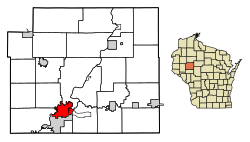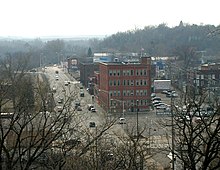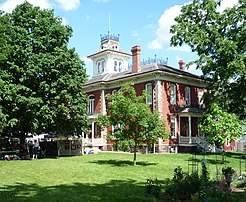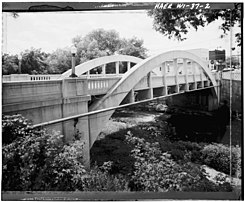Chippewa Falls, Wisconsin
Chippewa Falls, Wisconsin | |
|---|---|
 Chippewa Falls Chamber Building Downtown | |
 Chippewa Falls logo | |
 Location of Chippewa Falls in Chippewa County, Wisconsin. | |
| Coordinates: 44°56′N 91°24′W / 44.933°N 91.400°WCoordinates: 44°56′N 91°24′W / 44.933°N 91.400°W | |
| Country | |
| State | |
| County | Chippewa |
| Government | |
| • Mayor | Greg Hoffman[1] |
| Area | |
| • Total | 11.86 sq mi (30.72 km2) |
| • Land | 11.32 sq mi (29.31 km2) |
| • Water | 0.54 sq mi (1.41 km2) |
| Elevation | 840 ft (256 m) |
| Population | |
| • Total | 13,661 |
| • Estimate (2019)[5] | 14,366 |
| • Density | 1,269.42/sq mi (490.12/km2) |
| Time zone | UTC-6 (Central (CST)) |
| • Summer (DST) | UTC-5 (CDT) |
| Zip code | 54729, 54774 (companies/organisations) |
| Area code(s) | 715 & 534 |
| FIPS code | 55-14575[6] |
| GNIS feature ID | 1563041[3] |
| Website | ci.chippewa-falls.wi.us |
Chippewa Falls is a city located on the Chippewa River in Chippewa County in the U.S. state of Wisconsin. The most recent census from 2010 shows that the population is 13,661. Incorporated as a city in 1869, it is the county seat of Chippewa County.[7]
The city's name originated from its location on the Chippewa River, which is named after the Ojibwe Native Americans. Chippewa is an alternative rendition of Ojibwe.
Chippewa Falls is the birthplace of Seymour Cray, known as the "father of supercomputing", and the headquarters for the original Cray Research. It is also the home of the Jacob Leinenkugel Brewing Company, the Heyde Center for the Arts, a showcase venue for artists and performers; Irvine Park, and the annual Northern Wisconsin State Fair. Chippewa Falls is 15 miles from the annual four-day music festivals Country Fest and Rock Fest.
History[]

Chippewa Falls was originally developed by European Americans to exploit area lumber resources. It later became a railroad town, though the main railroad line of the 1870s ran about 10 miles south of Eau Claire. In 1870, the West Wisconsin Railway built a line from St. Paul, Minnesota, to Milwaukee, running right through Eau Claire.
Following this, the Eau Claire and Chippewa Falls Railway established a line extending from Eau Claire to Chippewa Falls. In 1880, the CF&W was joined by the Wisconsin and Minnesota Railway pushing its way west from Abbotsford. This was followed in 1881 by the Chippewa Falls & Northern Railroad, which built a line north from Chippewa Falls to Bloomer, eventually extending it to Superior.
Around 1700, French explorer Pierre-Charles Le Sueur discovered the Chippewa Spring near the river. The Ojibwe had long enjoyed its waters.
Such natural springs gained renewed attention in the late 19th century. Politician Thaddeus C. Pound founded the Chippewa Springs Health Club in 1887, and at one point oversaw the company that bottled the spring water for sale. A Spring House was built over the original spring in 1893. It remains today, across from the modern water bottling plant on Park Ave.[8]
Geography[]
Chippewa Falls is located at 44.9341, -91.3932.
According to the United States Census Bureau, the city has a total area of 11.92 square miles (30.87 km2), of which 11.37 square miles (29.45 km2) is land and 0.55 square miles (1.42 km2) is water.[9]
Climate[]
| ||||||||||||||||||||||||||||||||||||||||||||||||||||||||||||||||||||||||||||
Demographics[]
| Historical population | |||
|---|---|---|---|
| Census | Pop. | %± | |
| 1870 | 2,507 | — | |
| 1880 | 3,982 | 58.8% | |
| 1890 | 8,670 | 117.7% | |
| 1900 | 8,094 | −6.6% | |
| 1910 | 8,893 | 9.9% | |
| 1920 | 9,130 | 2.7% | |
| 1930 | 9,539 | 4.5% | |
| 1940 | 10,368 | 8.7% | |
| 1950 | 11,088 | 6.9% | |
| 1960 | 11,708 | 5.6% | |
| 1970 | 12,351 | 5.5% | |
| 1980 | 12,270 | −0.7% | |
| 1990 | 12,727 | 3.7% | |
| 2000 | 12,925 | 1.6% | |
| 2010 | 13,661 | 5.7% | |
| 2020 (est.) | 14,407 | [11] | 5.5% |
| WI Counties 1900-1990 | |||
2010 census[]
As of the census[4] of 2010, there were 13,661 people, 5,896 households, and 3,275 families living in the city. The population density was 1,201.5 inhabitants per square mile (463.9/km2). There were 6,304 housing units at an average density of 554.4 per square mile (214.1/km2). The racial makeup of the city was 95.1% White, 1.7% African American, 0.7% Native American, 0.9% Asian, 0.2% from other races, and 1.4% from two or more races. Hispanic or Latino of any race were 1.6% of the population.
There were 5,896 households, of which 29.1% had children under the age of 18 living with them, 37.7% were married couples living together, 13.0% had a female householder with no husband present, 4.9% had a male householder with no wife present, and 44.5% were non-families. 37.6% of all households were made up of individuals, and 16.7% had someone living alone who was 65 years of age or older. The average household size was 2.18 and the average family size was 2.86.
The median age in the city was 38 years. 22.9% of residents were under the age of 18; 9.1% were between the ages of 18 and 24; 27.1% were from 25 to 44; 24.6% were from 45 to 64; and 16.4% were 65 years of age or older. The gender makeup of the city was 50.7% male and 49.3% female.
2000 census[]
At the 2000 census,[6] there were 12,925 people, 5,638 households and 3,247 families living in the city. The population density was 1,191.2 per square mile (459.9/km2). There were 5,905 housing units at an average density of 544.2 per square mile (210.1/km2). The racial makeup of the city was 97.62% White, 0.30% African American, 0.46% Native American, 0.67% Asian, 0.01% Pacific Islander, 0.16% from other races, and 0.77% from two or more races. Hispanic or Latino of any race were 0.63% of the population.
There were 5,638 households, of which 28.8% had children under the age of 18 living with them, 42.4% were married couples living together, 11.3% had a female householder with no husband present, and 42.4% were non-families. 36.5% of all households were made up of individuals, and 16.4% had someone living alone who was 65 years of age or older. The average household size was 2.20 and the average family size was 2.89.
Age distribution was 24.2% under the age of 18, 9.4% from 18 to 24, 28.2% from 25 to 44, 20.3% from 45 to 64, and 17.9% who were 65 years of age or older. The median age was 37 years. For every 100 females, there were 89.5 males. For every 100 females age 18 and over, there were 85.2 males.
The median household income was $32,744, and the median family income was $43,519. Males had a median income of $32,016 versus $22,655 for females. The per capita income for the city was $18,366. About 8.7% of families and 10.3% of the population were below the poverty line, including 15.5% of those under age 18 and 5.8% of those age 65 or over.
Economy[]

As of 2011, the largest employers in the city were:[12]
| 1 | TTM Advanced Circuits |
| 2 | Chippewa Falls Public Schools |
| 3 | Saint Joseph's Hospital |
| 4 | Wal-Mart |
| 5 | Mason Companies Inc |
| 6 | Chippewa County |
| 7 | Silicon Graphics International |
| 8 | Cooperative Educational Service Agency #10 |
| 9 | Cray Inc |
| 10 | Wissota Healthcare Regional Vent CT |
Infrastructure[]
Chippewa Falls is along U.S. Highway 53, Wisconsin Highways 124 and 178, and Bus. WIS 29. Other routes include Wisconsin Highway 29; and County Highways J, Q, S, and X.
Education[]

The Chippewa Falls Area School District (CFSD) serves the city of Chippewa Falls. It has two high schools: Chippewa Falls Senior High and Chippewa Falls Alternate High School; two middle schools: Chippewa Falls Middle School, and Chippewa Falls Alternate Middle School; and six elementary schools: Parkview, Hillcrest, Southview, Stillson, Halmstad, and Jim Falls Elementary.
In addition there are several parochial schools: McDonell Central Catholic High School, Notre Dame Middle School, Holy Ghost, St. Charles, and St. Peter Elementary Schools, all of which are part of the McDonell Area Catholic Schools (MACS).
The original McDonell High School building, constructed at a prominent location above downtown Chippewa Falls, is listed on the State and National Register of Historic Places. The structure was built in 1907. After the high school was relocated to a new building in a more suburban location, this structure was vacant for several years. It was taken over by the Chippewa Valley Cultural Association and converted into the Heyde Center for the Arts in 2000.
Notable people[]
Politicians[]
- Edward Ackley - member of the Wisconsin State Senate
- William B. Bartlett - member of the Wisconsin State Assembly
- Howard W. Cameron - member of the Wisconsin State Senate
- Wilder W. Crane, Jr. - member of the Wisconsin State Assembly
- Gary Grant, member of the Washington House of Representatives
- Leo Richard Hamilton - member of the Wisconsin State Assembly
- Thomas S. Hogan - Montana Secretary of State
- John J. Jenkins - U.S. Representative
- Henry Laycock - member of the Wisconsin State Assembly
- Terry Moulton - a politician and member of the Wisconsin State Senate
- Dick Leinenkugel - a politician and businessman with Leinenkugels. Served as the Wisconsin Secretary of Commerce under governor Jim Doyle.
- Hector McRae - member of the Wisconsin State Assembly
- Charles F. Morris - member of the Wisconsin State Assembly
- Arthur L. Padrutt - member of the Wisconsin State Senate
- Bruce Peloquin - member of the Wisconsin State Senate
- Bradley Phillips - member of the Wisconsin State Assembly
- Thaddeus C. Pound - U.S. Representative, grandfather of poet Ezra Pound
- Ingolf E. Rasmus - lawyer and member of the Wisconsin State Assembly
- Marvin J. Roshell - member of the Wisconsin State Senate
- Lycurgus J. Rusk - member of the Wisconsin State Assembly
- Chuck Schafer - member of the Wisconsin State Assembly
- Tom Sykora - elected to Wisconsin State Assembly in 1994[13] and served until retirement in 2003[14]
- John W. Thomas - member of the Wisconsin State Assembly
- Alexander Wiley - served four terms in the United States Senate for the state of Wisconsin from 1939 to 1963
- Terry A. Willkom - member of the Wisconsin State Assembly
- Cadwallader Jackson Wiltse - member of the Wisconsin State Assembly
Military[]
- Horace Ellis - Medal of Honor recipient[15]
- Irving J. Carr - U.S. Army Major General
- Richard H. Cosgriff - Medal of Honor recipient
- George Clay Ginty - Union Army general
- James J. LeCleir - U.S. Air Force Major General
- Charles E. Mower - United States Army soldier and Medal of Honor recipient in World War II
- Dennis B. Sullivan - U.S. Air Force Brigadier General
Sports[]
- Moose Baxter - John Morris Baxter, former Major League Baseball player
- Chad Cascadden - National Football League linebacker for New York Jets and New England Patriots 1995-99
- Art Crews - professional wrestler, now Jail Captain with Chippewa County Sheriff's Department
- Nate DeLong - National Basketball Association player
- Charles E. "Gus" Dorais (1891–1954) - quarterback and kicker for the University of Notre Dame; inducted in College Football Hall of Fame as a coach in 1954; head coach of Detroit Lions from 1943–1947
- Gene Ellenson - professional football player in 1946[16]
- Joe Vavra - player for Los Angeles Dodgers, coach for Minnesota Twins; enshrined in Chi-Hi Athletic Hall of Fame on August 27, 2010
Law[]
- Russell G. Cleary - businessman and lawyer
- Thomas Eugene Grady - Justice of the Washington Supreme Court
- Donald F. Turner - lawyer and economist, Assistant Attorney General in charge of USDOJ's Antitrust Division under President Lyndon Baines Johnson
Other[]
- Judy Henske - singer and songwriter, "Queen of the Beatniks"; songs about Chippewa roots include "The Ballad of Seymour Cray"
- Howard "Guitar" Luedtke - blues guitarist, singer, songwriter and musician who tours with his band, Howard "Guitar" Luedtke & Blue Max
- Eddy Waller (1889 – 1977) - actor who appeared in over 200 films between 1929 and 1963
- Andrew S. Cray - LGBT Rights Activist
- Seymour Cray (1925–1996) - electrical engineer and supercomputer architect who founded Cray Research
- William F. Kirk (1877–1927) - nationally syndicated columnist, poet, songwriter, humorist and baseball writer
Important structures[]

The Cook-Rutledge House is on the National Register of Historic Places.
Hotel Chippewa is on the National Register of Historic Places.

Municipal Building

Spring Street Bridge Chippewa Falls, WI

Jacob Leinenkugel Brewing Company brewery.
In popular culture[]
In the Oscar-winning film Annie Hall, the title character, portrayed by Diane Keaton, originates from Chippewa Falls.
In the Oscar-winning film Titanic, Jack Dawson, portrayed by Leonardo DiCaprio says that his family is from Chippewa Falls.
Notes[]
- ^ "Mayor and City Council Members | City of Chippewa Falls, WI". www.chippewafalls-wi.gov.
- ^ "2019 U.S. Gazetteer Files". United States Census Bureau. Retrieved August 7, 2020.
- ^ Jump up to: a b "US Board on Geographic Names". United States Geological Survey. 2007-10-25. Retrieved 2008-01-31.
- ^ Jump up to: a b "U.S. Census website". United States Census Bureau. Retrieved 2012-11-18.
- ^ "Population and Housing Unit Estimates". United States Census Bureau. May 24, 2020. Retrieved May 27, 2020.
- ^ Jump up to: a b "U.S. Census website". United States Census Bureau. Retrieved 2008-01-31.
- ^ "Find a County". National Association of Counties. Archived from the original on 2015-05-10. Retrieved 2011-06-07.
- ^ Chippewa Springs Archived 2008-12-11 at the Wayback Machine, Chippewa County Tourism Council, Accessed July 19, 2009.
- ^ "US Gazetteer files 2010". United States Census Bureau. Archived from the original on 2012-01-24. Retrieved 2012-11-18.
- ^ "NASA Earth Observations Data Set Index". NASA. Retrieved 30 January 2016.
- ^ "County Population Totals: 2010-2020". Retrieved June 20, 2021.
- ^ "Home Page - WisConomy". jobcenterofwisconsin.com.
- ^ "Wisconsin History". Retrieved 2010-06-01.
- ^ "Wisconsin Legislative Spotlight". Archived from the original on 2005-09-12. Retrieved 2010-06-01.
- ^ "Horace Ellis - Recipient - Military Times Hall Of Valor". valor.militarytimes.com.
- ^ "Gene Ellenson at www.pro-football-reference.com". Retrieved 2009-05-06.
External links[]
| Wikimedia Commons has media related to Chippewa Falls, Wisconsin. |
| Wikivoyage has a travel guide for Chippewa Falls, Wisconsin. |
- Cities in Chippewa County, Wisconsin
- Cities in Wisconsin
- County seats in Wisconsin
- Eau Claire–Chippewa Falls metropolitan area
- 1869 establishments in Wisconsin








